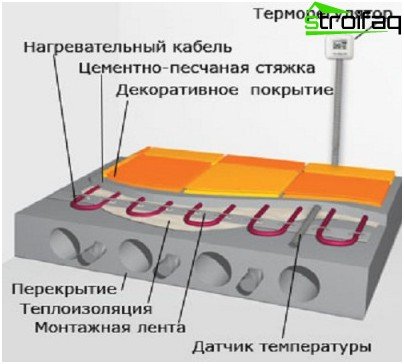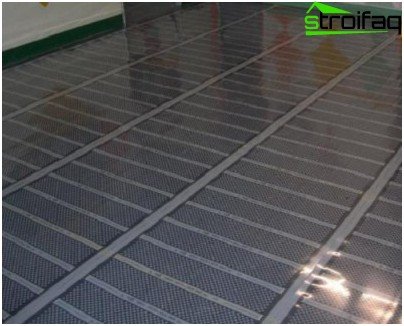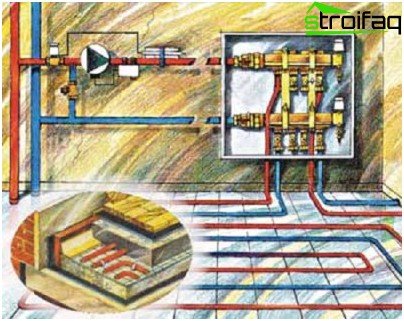Which underfloor heating floor is better?
The floor tiles have a lot of advantages – it is practical, beautiful, durable. Among other things, there is another remarkable quality – good thermal conductivity. This is an ideal coating for the underfloor heating system: recall that the heating elements, located under the floor covering, warm the room. Thus, the pleasant coolness of the tiles, which we value so much in the summer heat, can be replaced by the comfortable warmth necessary in the autumn-winter period. There are several types of underfloor heating systems. We will consider them in more detail to find out which warm floor under the tile is best suited.
Content
- Classification of underfloor heating systems
- Electric tiled floor
- Tiled infrared floor
- Installation of a film heat-insulated floor
- Tiled water floor
Compared with a radiator heating system, laying a warm floor under a tile has several advantages: the natural humidity of the air in the room is preserved, heat is evenly distributed. But most importantly – the effectiveness of the system underfloor heating under the tile – the reviews are only positive, because the tile serves as a kind of heat accumulator.
Classification of underfloor heating systems
- Electric underfloor heating (film, cable).
- Water floor heating.
- Electric tiled floor
It is used as the main or additional heat source. Electric cable underfloor heating for tiles can be implemented with single-core, two-core or ultra-thin cable (the so-called “mats”). An electric cable is laid in the floor device, and electricity is connected through a thermostat. A single-core or two-core cable is mounted only in a sand-cement screed.
A single-core cable is cheaper, but it must be returned to the thermostat, unlike a two-core cable, which can be used for laying in rooms of any layout. The screed adds an additional 3-5 cm to the floor, and after laying the tile the floor will be 4-6 cm higher. The sand-cement screed “steals” the height of the room, but at the same time it accumulates heat while preserving energy.

Tile electric underfloor heating
It can only be turned on after the screed has completely solidified. When installing an electric floor represented by “mats”, an additional sand-cement screed is not required. An ultra-thin cable laid on a polymer mesh base in a certain sequence is characterized by increased strength and insulation resistance. Installation of such a mat is carried out in a layer of glue under the tile on an old screed. The floor level in this case will rise no more than 1.5 cm (the height of the layer of tile adhesive and tile). Additional thermal insulation is not required. It is important to correctly calculate the area of the mat, rounding down. You can’t cut anything off the mat. Let us consider in more detail the features of installing an electric heated floor in a video.
The laying area of any electric underfloor heating system does not correspond to the area of the room, but is calculated only on the free area. Consider laying a warm floor in the bathroom. Do not allow the laying of a warm floor under the washing machine, pedestal of the sink, under the toilet and under the bathroom, the area on which the static furniture is also not counted.
Tiled infrared floor
One of the varieties of electric underfloor heating. Consists of flat plates sealed in plastic film (to prevent contact of work items with moisture). Depending on the heating material, there are carbon and bimetallic film floors. Under the tile, you can use only carbon. Such a floor does not corrode; if a floor section is damaged, only the damaged section is switched off (parallel connection).

The infrared floor heating device will practically not change the height of the ceiling in the room
Heat losses are insignificant, it works silently. The infrared film heating system is powered by a network, controlled by a temperature controller. The installation of a heated floor under a tile in case an infrared film floor is used has a number of features: it is mandatory to use a substrate with a heat-reflecting effect (a rolled technical cork, 2 mm thick is best.), Before installing the tile on the film floor, it is imperative to install a mounting fiberglass mesh with cells no more than 3 cm.
Installation of a film heat-insulated floor
Film floors come with different heating parameters. The sizes of the canvases are also different. In the event that a large room is to be insulated, it is advisable to use wide canvases with a width of 1 m or more. The heat regulator is bought separately. Its power is not difficult to calculate: the energy consumption of 1 m2 of film is approximately 150 watts. To find out the power consumption of the device, you should multiply 150 by the number of square meters that should be covered with a film floor. The size of the working area, as in the case of electric cable floors, does not correspond to the area of the room: usually about 75% of the area is covered, avoiding the place where static furniture and sanitary ware are located. The substrate is laid on a clean surface, fastening the cut points with tape.
Next, an infrared film is placed, the edges of the material are cut. It is necessary to insulate the edges. The temperature sensor must be placed in the groove under the film near the thermostat, fixing with tape to the film. The cable should fit right under the tile. To prevent the film floor from moving when laying the tiles, it should be fixed with adhesive tape to the substrate. The next step is the installation of a thermostat. It must be placed next to the wiring. The temperature controller is installed stationary, like a socket. Then follows the laying of wires, the connection to the network is parallel. Installation cables are best used in two colors. One cable of the same color is connected to one terminal of each strip of the film floor.

Installation of electric underfloor heating: applying a screed over a laid infrared film
You can lay the wires under the baseboard or make a strob in the wall for a hidden connection cable. To connect the wires to the heating material, put the terminals on the film and secure with pliers. The clamp should fit snugly against the copper conductor. Next, fix the cable and install the insulators. You can use sealant (squeeze a small amount of sealant onto one of the insulator halves and close the terminal with both halves). The connection of the wires to the thermostat must be carried out according to the connection diagram. If the system power is more than 2 W, connection is only necessary through a specially installed machine.
Tiled water floor
When heating a large area, it is advantageous to use a water heated floor (heated water circulates through the pipes). Such heating ensures uniform heating of the room, can be part of a fully autonomous heating system, it is possible to connect to a heating plant. Installation costs are one-time, the floor does not require maintenance. One of the advantages can be called energy savings. It should be noted the complexity of installing such a system and the mandatory use of additional equipment (water pump) In case of malfunctions, local repair is difficult. Pipes for the water floor are made of metal-plastic and are not subject to corrosion, the inner diameter of the pipes does not decrease over time due to the special device that prevents the accumulation of deposits.
With all the apparent simplicity of the process, installing a warm floor under a tile requires certain skills. In order for the tile not to peel off, it is important to follow all installation rules. For clarity, consider how to install a warm floor under the tile: the photo is presented below.

Water underfloor heating under the tile: device diagram and principle of operation
The answer to the question posed in the heading cannot be unambiguous. If the prospect of laying a warm floor using a sand-cement screed does not scare and a decision is made to install an electric cable floor, it is better to use a two-core cable: it is more convenient than a single-core cable. Water floor heating allows you to save on electricity consumption, ideal when you need to heat large areas.






